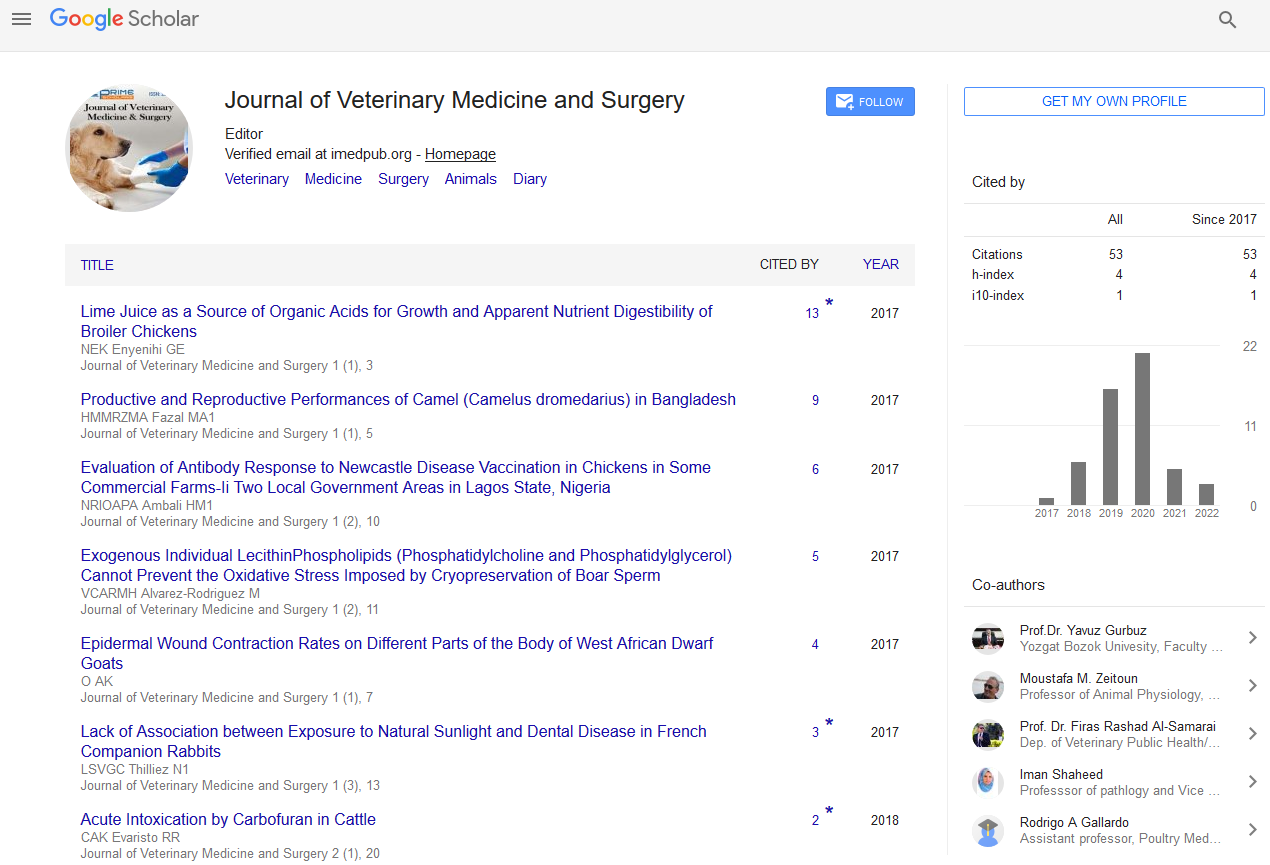Short Communication - (2023) Volume 7, Issue 4
Nairobi Sheep Disease: Unraveling the Mysteries of a Virulent Tick-Borne Infection
Roberts Dawson*
Department of Veterinary Medicine, Royal Veterinary College, UK
*Correspondence:
Roberts Dawson,
Department of Veterinary Medicine, Royal Veterinary College,
UK,
Email:
Received: 29-Nov-2023, Manuscript No. IPJVMS-23-19227;
Editor assigned: 01-Dec-2023, Pre QC No. IPJVMS-23-19227 (PQ);
Reviewed: 15-Dec-2023, QC No. IPJVMS-23-19227;
Revised: 20-Dec-2023, Manuscript No. IPJVMS-23-19227 (R);
Published:
27-Dec-2023, DOI: 10.36648/2574-2868.7.4.32
Introduction
Nairobi Sheep Disease (NSD), a tick-borne viral infection
primarily affecting sheep and goats, has emerged as a
significant concern for livestock health in various parts of the
world. The disease, caused by the Nairobi Sheep Disease Virus
(NSDV), belongs to the genus Nairovirus within the family
Bunyaviridae. This article explores the history, epidemiology,
clinical manifestations, diagnosis, prevention, and ongoing
research efforts surrounding Nairobi Sheep Disease, shedding
light on the complexities of this infectious agent and its impact
on global agriculture. Nairobi Sheep Disease was first identified
in 1910 in the region of Nairobi, Kenya, from which the
disease derives its name. The initial observations noted severe
illness and mortality in sheep and goats, prompting further
investigations into the causative agent. The discovery of the
Nairobi sheep disease virus marked the beginning of research
aimed at understanding the virus’s biology, transmission,
and impact on livestock populations. Nairobi Sheep Disease
has been reported in various parts of Africa, including Kenya,
Sudan, Tanzania, and Uganda. Additionally, cases have been
documented in regions outside Africa, such as the Middle East
and the Indian subcontinent. The primary vectors responsible
for transmitting NSDV are ticks of the genus Rhipicephalus,
particularly Rhipicephalus appendiculatus. These ticks serve as
both vectors and reservoir hosts for the virus, playing a crucial
role in the transmission cycle.
Description
While sheep and goats are the primary hosts and the most
severely affected by NSDV, the virus has been identified in
other domesticated animals, including cattle. Wild ruminants
may also play a role in the maintenance of the virus in certain
ecosystems. The incidence of Nairobi Sheep Disease often
exhibits seasonal variations, correlating with the activity of the
vector ticks. In regions with distinct wet and dry seasons, higher
transmission rates may occur during periods of increased tick
activity. Nairobi Sheep Disease Virus (NSDV) is classified as a
nairovirus, a group of viruses within the Bunyaviridae family.
Nairoviruses are characterized by a segmented, negative-sense
RNA genome. Ticks acquire the virus by feeding on infected
animals, becoming infected for life. Once infected, ticks can
transmit the virus to susceptible animals during subsequent
blood meals. Vertical transmission from infected female ticks
to their offspring is also documented. NSDV primarily targets
endothelial cells, causing vascular damage and disruption. This
vascular pathology contributes to the clinical signs and severe
manifestations observed in infected animals. The clinical
presentation of Nairobi Sheep Disease can vary, ranging from
subclinical infections to severe, acute cases with high mortality
rates. Common clinical manifestations include: Infected animals
often exhibit fever and lethargy, accompanied by a noticeable
decline in activity levels [1-4].
Conclusion
Nairobi Sheep Disease stands as a significant challenge in the
realm of animal health, impacting the livelihoods of farmers and
the agricultural industry. The intricate interplay between the
virus, ticks, and susceptible hosts underscores the complexity
of the disease and the need for multifaceted control measures.
Ongoing research and collaborative efforts in diagnostics,
prevention, and treatment hold the key to mitigating the impact
of Nairobi Sheep Disease on global livestock populations. As we
delve deeper into the intricacies of this tick-borne viral infection,
the knowledge gained contributes not only to the well-being of
livestock but also to our understanding of emerging infectious
diseases with zoonotic potential.
Acknowledgement
None.
Conflict Of Interest
None.
References
- Krasteva S, Jara M, Frias-De-Diego A, Machado G (2020) Nairobi sheep disease virus: A historical and epidemiological perspective. Front Vet Sci 7:419.
[Crossref] [Google Scholar] [PubMed]
- Maze EA, Chrun T, Booth G, Limon G, Charleston B, et al. (2023) Generation and characterisation of monoclonal antibodies against Nairobi sheep disease virus nucleoprotein. Viruses 15(9):1876.
[Crossref] [Google Scholar] [PubMed]
- Bin Tarif A, Lasecka L, Holzer B, Baron MD (2012) Ganjam virus/Nairobi sheep disease virus induces a pro-inflammatory response in infected sheep. Vet Res 43(1):71.
[Crossref] [Google Scholar] [PubMed]
- Marczinke BI, Nichol ST (2002) Nairobi sheep disease virus, an important tick-borne pathogen of sheep and goats in Africa, is also present in Asia. Virology 303(1):146-151.
[Crossref] [Google Scholar] [PubMed]
Citation: Dawson R (2023) Nairobi Sheep Disease: Unraveling the Mysteries of a Virulent Tick-borne Infection. J Veterinary Med. 7:32.
Copyright: © 2023 Dawson R. This is an open-access article distributed under the terms of the Creative Commons Attribution License, which permits unrestricted use, distribution, and reproduction in any medium, provided the original author and source are credited.

